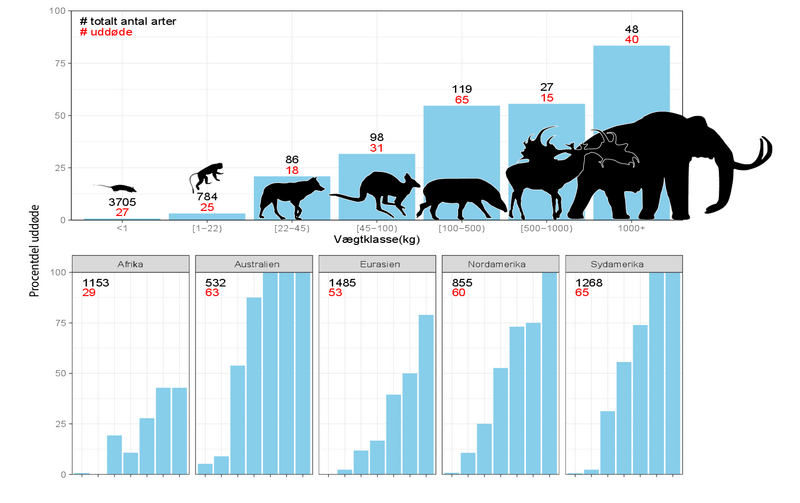Human Hunting and the Extinction of Megafauna: A 50,000-Year Review
Human Impact on Large Mammal Extinction
The debate over what caused the extinction of many large mammals, birds, and reptiles over the past 50,000 years has been ongoing for decades. Were humans or climate change responsible for these losses? Recent research1 suggests a compelling answer.
Defining Megafauna and the Extinction Crisis
Megafauna refers to animals weighing at least 45 kilograms. Over the past 50,000 years, at least 161 species of such large mammals have been driven to extinction. This figure includes many of the largest land-dwelling herbivores, known as megaherbivores, which weighed over a ton. Fifty thousand years ago, 57 species of megaherbivores existed; today, only 11 remain, and these have seen significant population declines.
The Role of Human Hunting
Researchers from the Danish National Research Foundation's Center for Ecological Dynamics in a Novel Biosphere (ECONOVO) at Aarhus University have concluded that human hunting played a decisive role in these extinctions. Their findings are presented in a review article published in the journal Cambridge Prisms: Extinction, which synthesizes and analyzes over 300 scientific articles across various research fields.

Multidisciplinary Evidence
The review incorporated studies directly related to the extinction of large animals, including:
The timing of species extinctions
Dietary preferences of the animals
Climate and habitat requirements
Genetic estimates of past population sizes
Evidence of human hunting
Additionally, it included studies from other fields necessary to understand the phenomenon, such as:
Climate history over the past 1-3 million years
Vegetation history over the past 1-3 million years
Evolution and dynamics of fauna over the past 66 million years
Archaeological data on human expansion and lifestyle, including dietary preferences
Climate Change: A Lesser Role
Significant climate changes during the last interglacial and glacial periods (the late Pleistocene, from 130,000 to 11,000 years ago) affected populations and distributions of both large and small animals and plants worldwide. However, only large animals, particularly the largest ones, experienced significant extinctions.
Previous ice ages and interglacials over the past few million years did not cause selective megafauna loss. Professor Jens-Christian Svenning of ECONOVO states,
"The large and very selective loss of megafauna over the last 50,000 years is unique over the past 66 million years. Previous periods of climate change did not lead to large, selective extinctions, which argues against a major role for climate in the megafauna extinctions. The recent megafauna extinctions hit just as hard in climatically stable areas as in unstable areas."
Human Hunting: Evidence and Impact
Archaeological evidence shows that early modern humans were effective hunters of large animals. Traps for very large animals have been found, and isotope analyses of ancient human bones and protein residues from spear points confirm that humans hunted and consumed the largest mammals. Svenning said,
"Early modern humans were effective hunters of even the largest animal species and clearly had the ability to reduce the populations of large animals. These large animals were and are particularly vulnerable to overexploitation because they have long gestation periods, produce very few offspring at a time, and take many years to reach sexual maturity."
The analysis indicates that human hunting of large animals such as mammoths, mastodons, and giant sloths was widespread and consistent across the world. The species went extinct at different times and rates globally, but everywhere it occurred after the arrival of modern humans or, in Africa, after significant cultural advancements among humans.
Extinction Across All Environments
Extinctions occurred on all continents except Antarctica and in all types of ecosystems, from tropical forests and savannas to Mediterranean and temperate forests and steppes to arctic ecosystems. Svenning explains,
"Many of the extinct species could thrive in various types of environments. Therefore, their extinction cannot be explained by climate changes causing the disappearance of a specific ecosystem type, such as the mammoth steppe. Most of the species existed under temperate to tropical conditions and should actually have benefited from the warming at the end of the last ice age."
Ecological Consequences and Conservation Efforts
The loss of megafauna has had profound ecological consequences. Large animals influence vegetation structure, seed dispersal, and nutrient cycling. Their disappearance has led to significant changes in ecosystem structures and functions. Svenning says,
"Our results highlight the need for active conservation and restoration efforts. By reintroducing large mammals, we can help restore ecological balances and support biodiversity, which evolved in ecosystems rich in megafauna.”
Conclusion
The evidence increasingly supports the conclusion that human hunting, rather than climate change, was the primary driver behind the extinction of large mammals over the past 50,000 years. This finding underscores the need for ongoing conservation efforts to mitigate the impact of human activities on the remaining large animal species and to restore ecological balances disrupted by the loss of megafauna.
Svenning, J.-C., Lemoine, R. T., Bergman, J., Buitenwerf, R., Le Roux, E., Lundgren, E., Mungi, N., & Pedersen, R. Ø. (2024). The late-Quaternary megafauna extinctions: Patterns, causes, ecological consequences and implications for ecosystem management in the Anthropocene. Cambridge Prisms: Extinction, 2(e5). https://doi.org/10.1017/ext.2024.4


